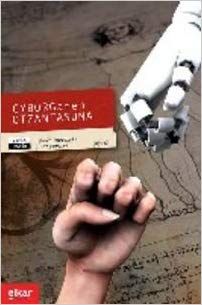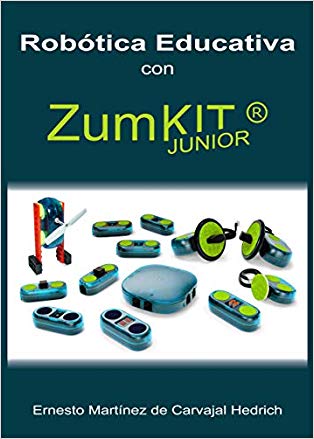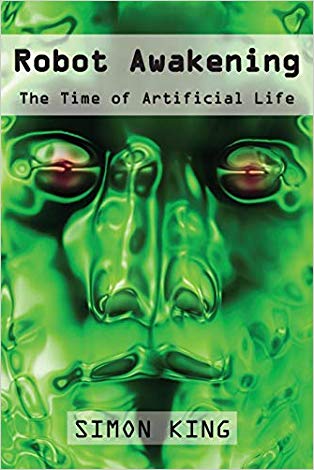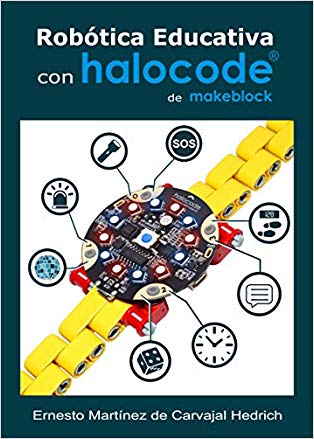SISTEMAS ROBÓTICOS (CHIU NAZARALA, RAUL)

PROYECTO NEXT-ROBÓTICA EDELVIVES. MISIONES SCRATCH – 5º PRIMARIA (BERNABÉU LORENTE, ALBERTO)

NEXT LEGO – ROBOTICS 5 : LEARN AND PROGRAM WITH NEXT 2.0 (EQUIPO EXODEGA)

CYBORGAREN OTZANTASUNA (BENGOETXEA COUSILLAS, JUAN BAUTISTA)
 Cyborga irudia, ideia edo metafora ez ezik, gauza erreal gisa ere erabiltzen du egileak. Zuk, nik, edozein gizakik teknologiarekin duen harremana, erabat barneraturikoa eta ia-ia beharrezkoa, islatzen du. Denok gara cyborgak neurri batean edo bestean eta hori abiapuntu bezala onartu beharko genuke. Baina nola? Hain zuzen ere otzanak ez izaten ahalegintzen. Hori da liburuaren bigarren abiapuntua, oso otzanak gara oro har, eta are gehiago oraindik teknologien aurrean erakusten dugun jarreran. Hortaz, liburuak hiru nozio gakoen inguruan hausnartzen du: gizakia, makina eta otzantasuna. Horiekin esperimentatzen du eta bost laborategi desberdinetan kokatzen ditu kontzeptuok. Horrela, lehendabizikoak fikzioaren lur mugikorra ezkutatzen du. Egon dira eta badaude cyborgari buruzko fikziozko istorio ugari, eta denak dira cyborgaren ideiaren parte neurri batean.
Cyborga irudia, ideia edo metafora ez ezik, gauza erreal gisa ere erabiltzen du egileak. Zuk, nik, edozein gizakik teknologiarekin duen harremana, erabat barneraturikoa eta ia-ia beharrezkoa, islatzen du. Denok gara cyborgak neurri batean edo bestean eta hori abiapuntu bezala onartu beharko genuke. Baina nola? Hain zuzen ere otzanak ez izaten ahalegintzen. Hori da liburuaren bigarren abiapuntua, oso otzanak gara oro har, eta are gehiago oraindik teknologien aurrean erakusten dugun jarreran. Hortaz, liburuak hiru nozio gakoen inguruan hausnartzen du: gizakia, makina eta otzantasuna. Horiekin esperimentatzen du eta bost laborategi desberdinetan kokatzen ditu kontzeptuok. Horrela, lehendabizikoak fikzioaren lur mugikorra ezkutatzen du. Egon dira eta badaude cyborgari buruzko fikziozko istorio ugari, eta denak dira cyborgaren ideiaren parte neurri batean.ROBÓTICA EDUCATIVA CON ZUM KIT JUNIOR (MARTÍNEZ DE CARVAJAL HEDRICH, ERNESTO)

ROBOT AWAKENING (KING, SIMON;HUDSON, ROCKY;ATHERTON, LIZ)
 The Newark Steam Man, Eric the mechanical man, Cygan the gigantic robot, WABOT-1 the intelligent anthrobot, REEM the humanoid service robot, ASIMO the little humanoid robot and Robonaut 2 the astronaut are only a few unique creations in the history of robotics. However, they outline the dramatic evolution that has occurred in robots over the past 150 years, and to an extent, their miniature robot counterparts in the toy kingdom also reflect this incredible diversity.Science fiction tales of robotic entities, such as sophisticated intelligent androids and gynoids, global communication networks controlled entirely by artificial intelligences, and even Space Age cartoons such as The Jetsons provide supporting insights into this evolutionary transition throughout the book.The 21st century is already experiencing innovative robotic advancements in development of artificially intelligent synthetic lifeforms and transforming many sectors of our society, particularly in the manufacturing, healthcare and hospitality industries as well as the worldwide Internet. Are we prepared for a society of emerging ?intelligent?
The Newark Steam Man, Eric the mechanical man, Cygan the gigantic robot, WABOT-1 the intelligent anthrobot, REEM the humanoid service robot, ASIMO the little humanoid robot and Robonaut 2 the astronaut are only a few unique creations in the history of robotics. However, they outline the dramatic evolution that has occurred in robots over the past 150 years, and to an extent, their miniature robot counterparts in the toy kingdom also reflect this incredible diversity.Science fiction tales of robotic entities, such as sophisticated intelligent androids and gynoids, global communication networks controlled entirely by artificial intelligences, and even Space Age cartoons such as The Jetsons provide supporting insights into this evolutionary transition throughout the book.The 21st century is already experiencing innovative robotic advancements in development of artificially intelligent synthetic lifeforms and transforming many sectors of our society, particularly in the manufacturing, healthcare and hospitality industries as well as the worldwide Internet. Are we prepared for a society of emerging ?intelligent?NEXT LEGO – ROBOTICS 6 : LEARN AND PROGRAM WITH NEXT 2.0 (EQUIPO EXODEGA)

AUTOMATISMES ELECTRICS I INDUSTRIALS (DURAN, J.L. / GAMIZ, J. / DOMINGO, J. / MARTINEZ, H.)
 TAULA DE CONTINGUTS1. Automatització bàsica.2. Comandament, regulació i maniobres en màquines elèctriques.3. Aplicacions amb autòmats programables.4. Mecànica bàsica.5. Quadres elèctrics.6. Detecció i diagnosi d'avaries en automatismes cablejats i programables.7. Reparació d'avaries en automatismes cablejats i/o programables.
TAULA DE CONTINGUTS1. Automatització bàsica.2. Comandament, regulació i maniobres en màquines elèctriques.3. Aplicacions amb autòmats programables.4. Mecànica bàsica.5. Quadres elèctrics.6. Detecció i diagnosi d'avaries en automatismes cablejats i programables.7. Reparació d'avaries en automatismes cablejats i/o programables.ROBÓTICA EDUCATIVA CON HALOCODE DE MAKEBLOCK (MARTÍNEZ DE CARVAJAL HEDRICH, ERNESTO)

XXXVI JORNADAS DE AUTOMÁTICA – LIBRO DE ACTAS (XXXVI JORNADAS DE AUTOMÁTICA)

CUADERNO DEL ALUMNO EXPERTO EN AUTÓMATAS PROGRAMABLES. FORMACIÓN PARA EL EMPLEO (EUROINNOVA EDITORIAL S.L.)
 Este cuaderno, junto con el manual teórico asociado, incluye un material dirigido favorecer el aprendizaje teórico-práctico del programa docente 'Experto en Autómatas Programables'. Está concebido como una guía de estudio y seguimiento del curso por parte del alumno, mediante la inclusión de información del temario, objetivos, recursos y distintos ejercicios de autoevaluación para cada Unidad. Se trata contenidos propios de acciones formativas dirigidas a la formación de trabajadores de ámbito sectorial: ? Planes de formación dirigidos a cualquier trabajador ocupado (cursos gratuitos) dentro del sector de referencia. ? Cursos de formación a trabajadores desempleados del sector no basados en la obtención de Certificados de Profesionalidad. ? Cursos de formación bonificada para empresas del ámbito sectorial.
Este cuaderno, junto con el manual teórico asociado, incluye un material dirigido favorecer el aprendizaje teórico-práctico del programa docente 'Experto en Autómatas Programables'. Está concebido como una guía de estudio y seguimiento del curso por parte del alumno, mediante la inclusión de información del temario, objetivos, recursos y distintos ejercicios de autoevaluación para cada Unidad. Se trata contenidos propios de acciones formativas dirigidas a la formación de trabajadores de ámbito sectorial: ? Planes de formación dirigidos a cualquier trabajador ocupado (cursos gratuitos) dentro del sector de referencia. ? Cursos de formación a trabajadores desempleados del sector no basados en la obtención de Certificados de Profesionalidad. ? Cursos de formación bonificada para empresas del ámbito sectorial.NEXT LEGO – ROBOTICS 3 : LEARN AND PROGRAM WITH NEXT 2.0 (EQUIPO EXODEGA)

MARINE AUTOMATION . PROCEEDINGS OF THE VII WORKSHOP ON MARINE AUTOMATION/SYSTEMS. AUTOMAR 2017
 El diseño de soluciones robóticas submarinas avanzadas requiere el trabajo integrado de científicos multidisciplinares de áreas como informática, inteligencia artificial, ingeniería eléctrica mecánica, así como destinatarios específicos como por ejemplo, arqueólogos. AUTOMAR es una red de investigadores dedicada a la automatización y robótica para la industria y para ciencias marítimas y oceánicas. Este libro compila todos los materiales multimedia generados en las VII Jornadas de Automática Marítima (AUTOMAR 2017), celebradas en la Universitat Jaume I, donde se puso énfasis especial en la proyección internacional y el ámbito específico de la arqueología submarina, con la intención de atraer a los investigadores y profesionales de todos los sectores relacionados con actividades marinas.
El diseño de soluciones robóticas submarinas avanzadas requiere el trabajo integrado de científicos multidisciplinares de áreas como informática, inteligencia artificial, ingeniería eléctrica mecánica, así como destinatarios específicos como por ejemplo, arqueólogos. AUTOMAR es una red de investigadores dedicada a la automatización y robótica para la industria y para ciencias marítimas y oceánicas. Este libro compila todos los materiales multimedia generados en las VII Jornadas de Automática Marítima (AUTOMAR 2017), celebradas en la Universitat Jaume I, donde se puso énfasis especial en la proyección internacional y el ámbito específico de la arqueología submarina, con la intención de atraer a los investigadores y profesionales de todos los sectores relacionados con actividades marinas.
